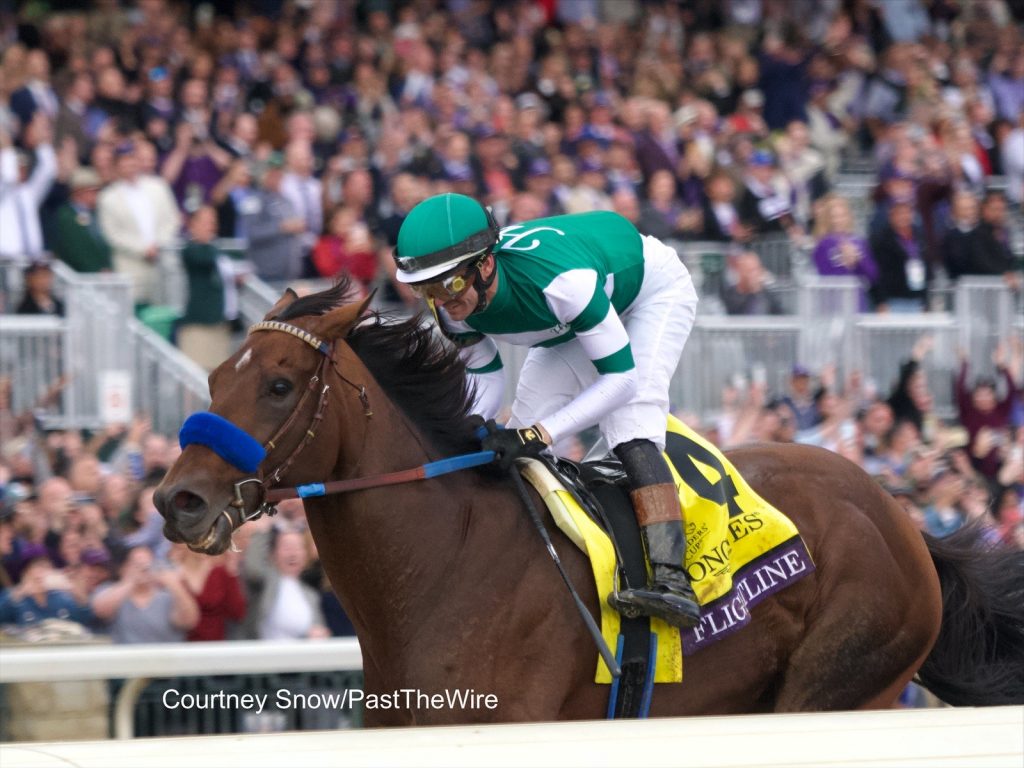
Panthalassa takes the Saudi Cup Feb. 25, 2023. (Erika Rasmussen)
By Michaela Moricova
On February 25, we saw the fourth renewal of the Saudi Cup, held in Riyadh, Saudi Arabia. The wealthy Middle Eastern country strives to make a name among renowned horse racing nations; therefore, they introduced Saudi Cup as the world’s richest race with a purse of $20,000,000. The meeting attracts exciting horses from Europe, the USA, and Japan. The money is tempting, and the range of races varies, yet the attempt raises a question: What it takes for an event to become an inseparable part of the global racing calendar?
Let’s look at the most famous meetings in the world and remind ourselves of their specifications and history, while in the second part of this mini-series, we’ll dive into the question of the potential of the Pegasus World Cup, Saudi Cup, and maybe even Dubai World Cup Night.

Engraved in History
It is not up to debate that long and rich history is beneficial for a race or meeting when gaining prestige. Royal Ascotwas established in the 19th century (although it operated somehow even in the 18th century) and has such a tradition that no other meeting can match it. There are always horses from France and Ireland; Wesley Ward sends his sprinters from the US. Moreover, Australians have become considerably bolder in their European endeavors since Black Caviar’s victory at Royal Ascot, and sometimes small teams from Central Europe venture there, too.
Indeed, all teams desire to succeed at Royal Ascot. However, even participating in any of the races during the four-day-long event is considered an achievement. Royal Ascot is a legend, and given its history, probably no meeting will match its status, at least in British eyes. They also treasure other meetings in their Flat calendar, e.g., Glorious Goodwood held in summer, boasting three G1 races, or British Champions Day in October. It’s officially the final day of the British Flat season, featuring the G1 Queen Elizabeth II Stakes and the G1 Champions Stakes.
The French Monument
Let’s stay in Europe. As I suggested, Royal Ascot is unreachable in terms of glory for events like the Dubai World Cup or Saudi Cup, but what about Prix de l’Arc de Triomphe? Well, it is the richest European race and the second-richest turf race in the world. That’s something. Moreover, its history dates back to the beginning of the 20th century. Tradition is on its side then, yet its ability to attract horses from outside Europe is rather limited as it lasts two days and offers a limited number of races. In addition, the meeting is usually held on very soft or even heavy ground, which is not something American or Australian horses thrive on.
Its prestige is mostly based on history, purse money, and also on its place within the schedule as the Prix de l’Arc de Triomphe embodies one of the peaks of the European Flat season where the best horses from the UK, Japan, Ireland, France, Germany, and usually also Spain, Italy, or the Czech Republic meet up. In Europe, everybody wants to send their horses to the Arc meeting, and even having a total outsider in ‘the Arc’ is considered an achievement regardless of the position the horse finishes in. Still, its prestige is more or less confined to Europe and Japan.
Bring on the Breeders’ Cup
The Breeders’ Cup World Championship proves that a century-long history isn’t necessary for a meeting to gain prestige. It was established in 1984 as a one-day event, but other races have been added over the years, so today, it spans two days and offers 14 G1 races over various distances and both on dirt and turf. Whereas Prix de l’Arc de Triomphe is perceived as one of the peaks of the European Flat season, the Breeders’ Cup sort of concludes the main part of the global Flat season with horses from all over the world heading there to compete for lucrative prizes.
The meeting maintains its overall high quality thanks to the invitational system, as only invited runners can participate in the US. This particular rule seems to be the leading reason for the Breeders’ Cup’s quick rise to the hill of worldwide meetings, even though its tradition is not that long.
Moreover, Breeders’ Cup was established due to the great hunger for such an event, and it keeps changing, adding, and cutting down certain races to satisfy the demand. Its ability to respond to the needs of modern horse racing proves to be crucial for its popularity as it keeps attracting horses from Europe and, most notably, Japan, which could be the leading racing force in the upcoming years.
Curious Couple in Australia

An interesting situation has unfolded in Australia. On the one hand, they have the Melbourne Cup that dates back to the 19th century. It’s the world’s most famous handicap, regularly luring guests from Europe and Japan; however, the new screening regulation prevented some European horses from traveling there. So, Australia has this phenomenal race to boast about, yet as it’s a handicap held at the end of the European Flat season, moreover, an ultra-long one in the world that focuses mainly on producing fast two-year-olds and three-year-olds. In other words, Melbourne Cup is a respected feat but interests only the locals and a bunch of devotees abroad.
And then there is The Everest. The richest turf race in the world lies on the opposite side of the distance spectrum than the Melbourne Cup. It’s a G1 sprint where owners buy the berths for their horses, and because Australia has excellent sprinters, you do not see teams from other countries compete against the locals. In addition, the system of paying for berths seems quite obsolete at this point, given also the Pegasus World Cup ceased from it. Therefore, the quality of The Everest’s field is questionable. Even though its winners are fine animals, if there is any prestige to the race, only the locals notice it.

…and Hong Kong
In December, European and Hong Kong horse racing devotees focus on the Hong Kong International Races. In the US, fans continue to be entertained by the Cigar Mile or Matriarch Stakes, but Europe and Japan await these races held at Sha Tin in Hong Kong. Regularly, Europeans send over especially stayers of G1 and G2 quality, but definitely not the biggest stars. Moreover, they pay little attention to other G1s on the card, leaving them to the Japanese and the locals to land the spoils. In other words, the meeting has some history and gives interesting prizes, but it’s mostly an Asian thing that lures some Europeans thanks to its position within the schedule.
What is the Conclusion?
Prestige certainly comes with tradition but having a long and rich history is unnecessary if you can offer something the teams worldwide desire. And it’s not only about big prizes, but also about a vast number of races and preferably a functional system of invitations. Because when you look at the meetings I’ve covered, we can talk for hours about history behind Royal Ascot or Prix de l’Arc de Triomphe and how we love them. Sure, these events are engraved in history and offer interesting prizes, but they are monuments. They do not change. They do not respond to the demand and do not try to attract guests from other parts of the world. Moreover, all of their races are held on turf, which is a limitation on its own.
Therefore, it seems fair to say that the Breeders’ Cup shows and paves the best way to achieving stardom. It does not lack basically anything, and its prestige and overall quality are kept high thanks to the system of invitations. Only the best can compete at the Breeders’ Cup, which makes the event sort of elitist, but… this is what contributes to the perception of Breeders’ Cup being an unofficial championship. In terms of history, length, number of races, etc., Royal Ascot beats the Breeders’ Cup, but Royal Ascot will probably remain the same. And possibly will stagnate, relying only on its fame and history in the future.
Breeders’ Cup is looking forward, and the organizers’ willingness to undergo changes maintains the Breeders’ Cupas the best example of the modern big racing meeting.




